Page 23 of 380
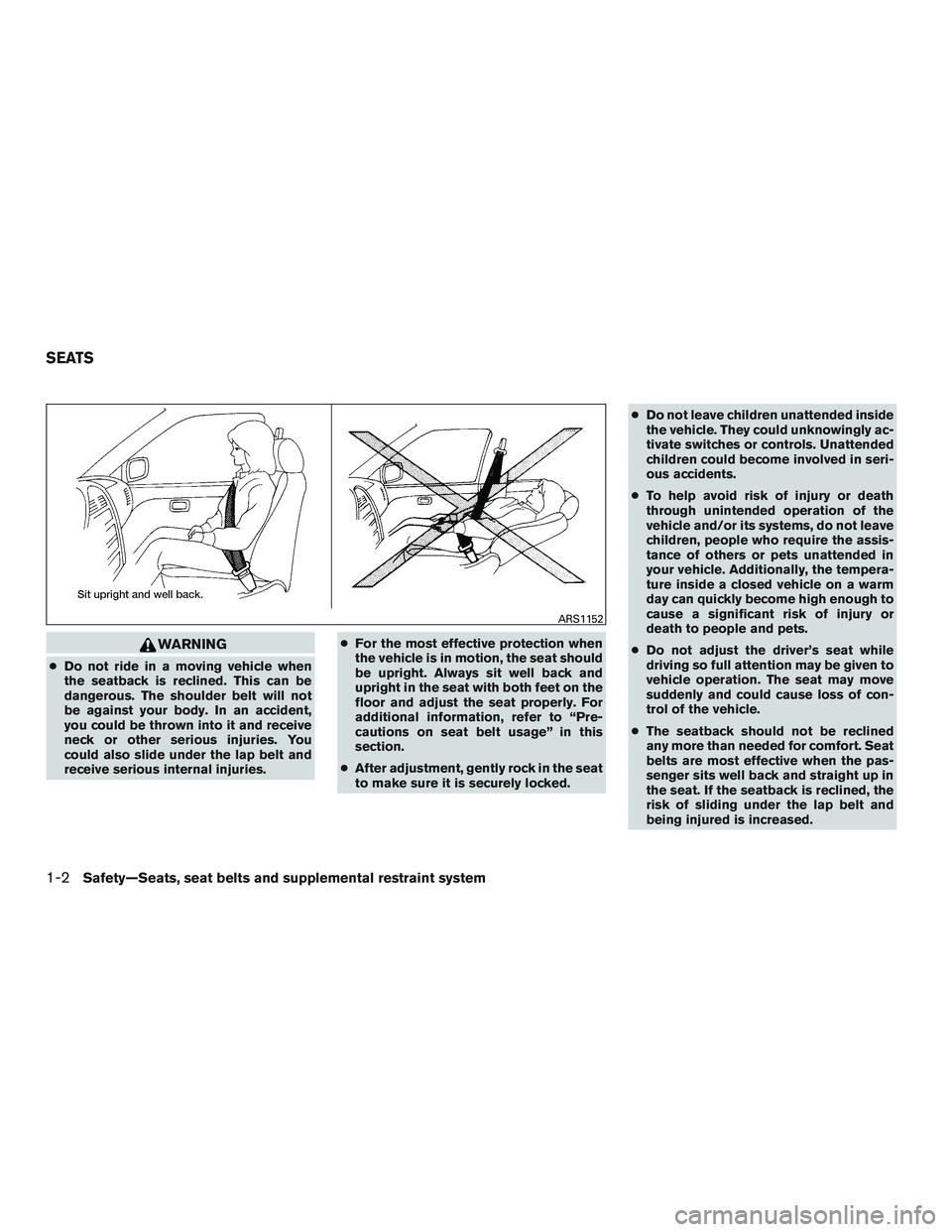
WARNING
●Do not ride in a moving vehicle when
the seatback is reclined. This can be
dangerous. The shoulder belt will not
be against your body. In an accident,
you could be thrown into it and receive
neck or other serious injuries. You
could also slide under the lap belt and
receive serious internal injuries. ●
For the most effective protection when
the vehicle is in motion, the seat should
be upright. Always sit well back and
upright in the seat with both feet on the
floor and adjust the seat properly. For
additional information, refer to “Pre-
cautions on seat belt usage” in this
section.
● After adjustment, gently rock in the seat
to make sure it is securely locked. ●
Do not leave children unattended inside
the vehicle. They could unknowingly ac-
tivate switches or controls. Unattended
children could become involved in seri-
ous accidents.
● To help avoid risk of injury or death
through unintended operation of the
vehicle and/or its systems, do not leave
children, people who require the assis-
tance of others or pets unattended in
your vehicle. Additionally, the tempera-
ture inside a closed vehicle on a warm
day can quickly become high enough to
cause a significant risk of injury or
death to people and pets.
● Do not adjust the driver’s seat while
driving so full attention may be given to
vehicle operation. The seat may move
suddenly and could cause loss of con-
trol of the vehicle.
● The seatback should not be reclined
any more than needed for comfort. Seat
belts are most effective when the pas-
senger sits well back and straight up in
the seat. If the seatback is reclined, the
risk of sliding under the lap belt and
being injured is increased.
ARS1152
SEATS
1-2Safety—Seats, seat belts and supplemental restraint system
Page 27 of 380
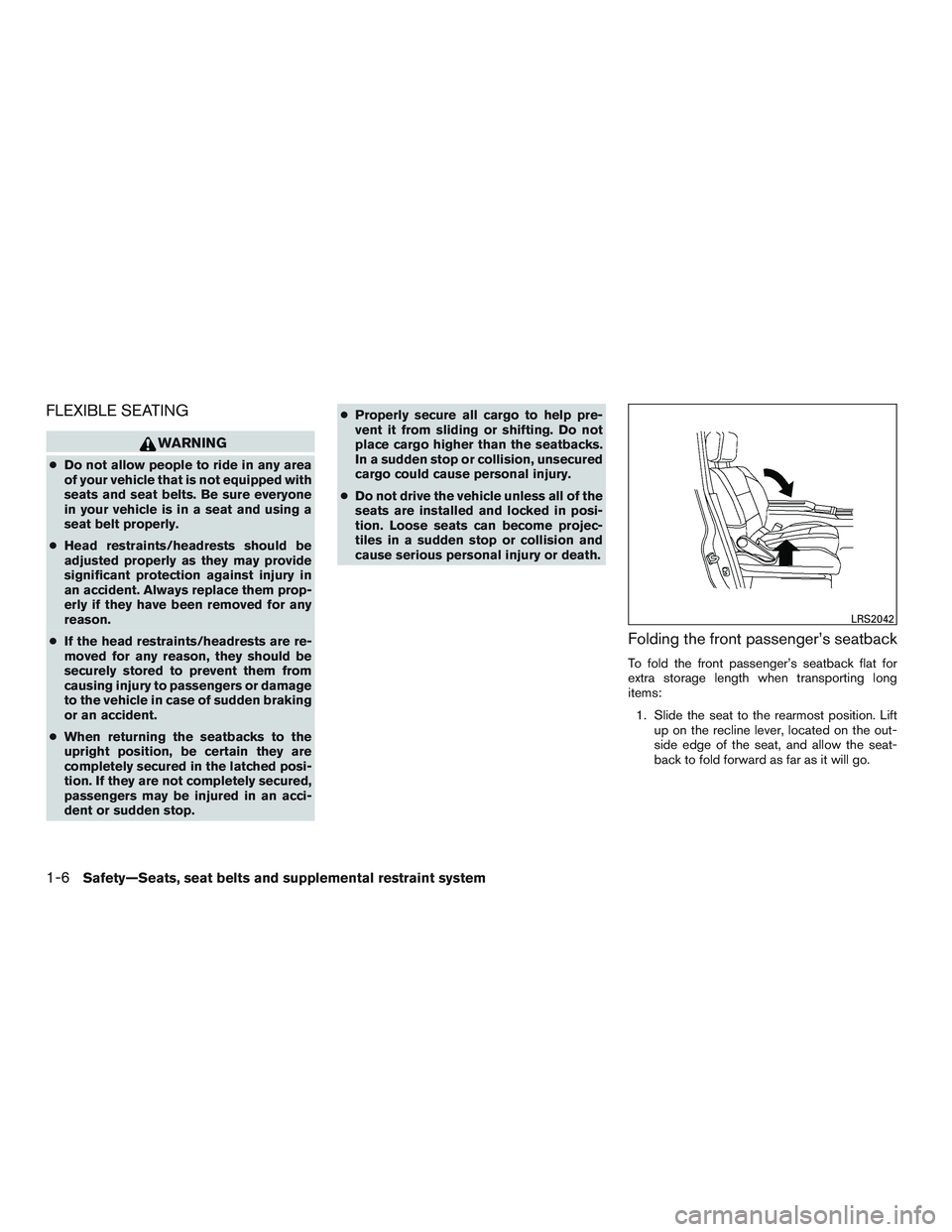
FLEXIBLE SEATING
WARNING
●Do not allow people to ride in any area
of your vehicle that is not equipped with
seats and seat belts. Be sure everyone
in your vehicle is in a seat and using a
seat belt properly.
● Head restraints/headrests should be
adjusted properly as they may provide
significant protection against injury in
an accident. Always replace them prop-
erly if they have been removed for any
reason.
● If the head restraints/headrests are re-
moved for any reason, they should be
securely stored to prevent them from
causing injury to passengers or damage
to the vehicle in case of sudden braking
or an accident.
● When returning the seatbacks to the
upright position, be certain they are
completely secured in the latched posi-
tion. If they are not completely secured,
passengers may be injured in an acci-
dent or sudden stop. ●
Properly secure all cargo to help pre-
vent it from sliding or shifting. Do not
place cargo higher than the seatbacks.
In a sudden stop or collision, unsecured
cargo could cause personal injury.
● Do not drive the vehicle unless all of the
seats are installed and locked in posi-
tion. Loose seats can become projec-
tiles in a sudden stop or collision and
cause serious personal injury or death.
Folding the front passenger’s seatback
To fold the front passenger’s seatback flat for
extra storage length when transporting long
items:
1. Slide the seat to the rearmost position. Lift up on the recline lever, located on the out-
side edge of the seat, and allow the seat-
back to fold forward as far as it will go.
LRS2042
1-6Safety—Seats, seat belts and supplemental restraint system
Page 28 of 380
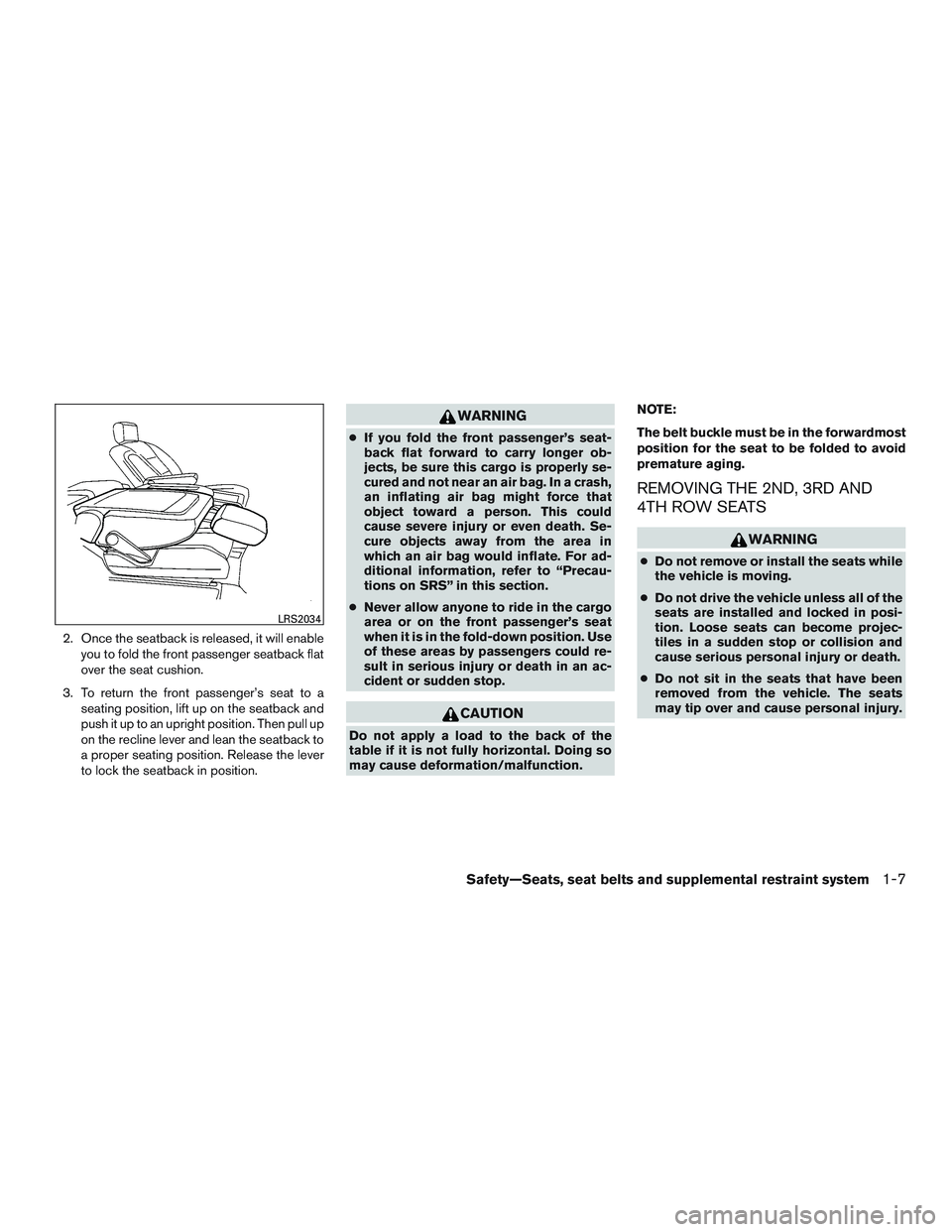
2. Once the seatback is released, it will enableyou to fold the front passenger seatback flat
over the seat cushion.
3. To return the front passenger’s seat to a seating position, lift up on the seatback and
push it up to an upright position. Then pull up
on the recline lever and lean the seatback to
a proper seating position. Release the lever
to lock the seatback in position.
WARNING
●If you fold the front passenger’s seat-
back flat forward to carry longer ob-
jects, be sure this cargo is properly se-
cured and not near an air bag. In a crash,
an inflating air bag might force that
object toward a person. This could
cause severe injury or even death. Se-
cure objects away from the area in
which an air bag would inflate. For ad-
ditional information, refer to “Precau-
tions on SRS” in this section.
● Never allow anyone to ride in the cargo
area or on the front passenger’s seat
when it is in the fold-down position. Use
of these areas by passengers could re-
sult in serious injury or death in an ac-
cident or sudden stop.
CAUTION
Do not apply a load to the back of the
table if it is not fully horizontal. Doing so
may cause deformation/malfunction. NOTE:
The belt buckle must be in the forwardmost
position for the seat to be folded to avoid
premature aging.
REMOVING THE 2ND, 3RD AND
4TH ROW SEATS
WARNING
●
Do not remove or install the seats while
the vehicle is moving.
● Do not drive the vehicle unless all of the
seats are installed and locked in posi-
tion. Loose seats can become projec-
tiles in a sudden stop or collision and
cause serious personal injury or death.
● Do not sit in the seats that have been
removed from the vehicle. The seats
may tip over and cause personal injury.
LRS2034
Safety—Seats, seat belts and supplemental restraint system1-7
Page 32 of 380
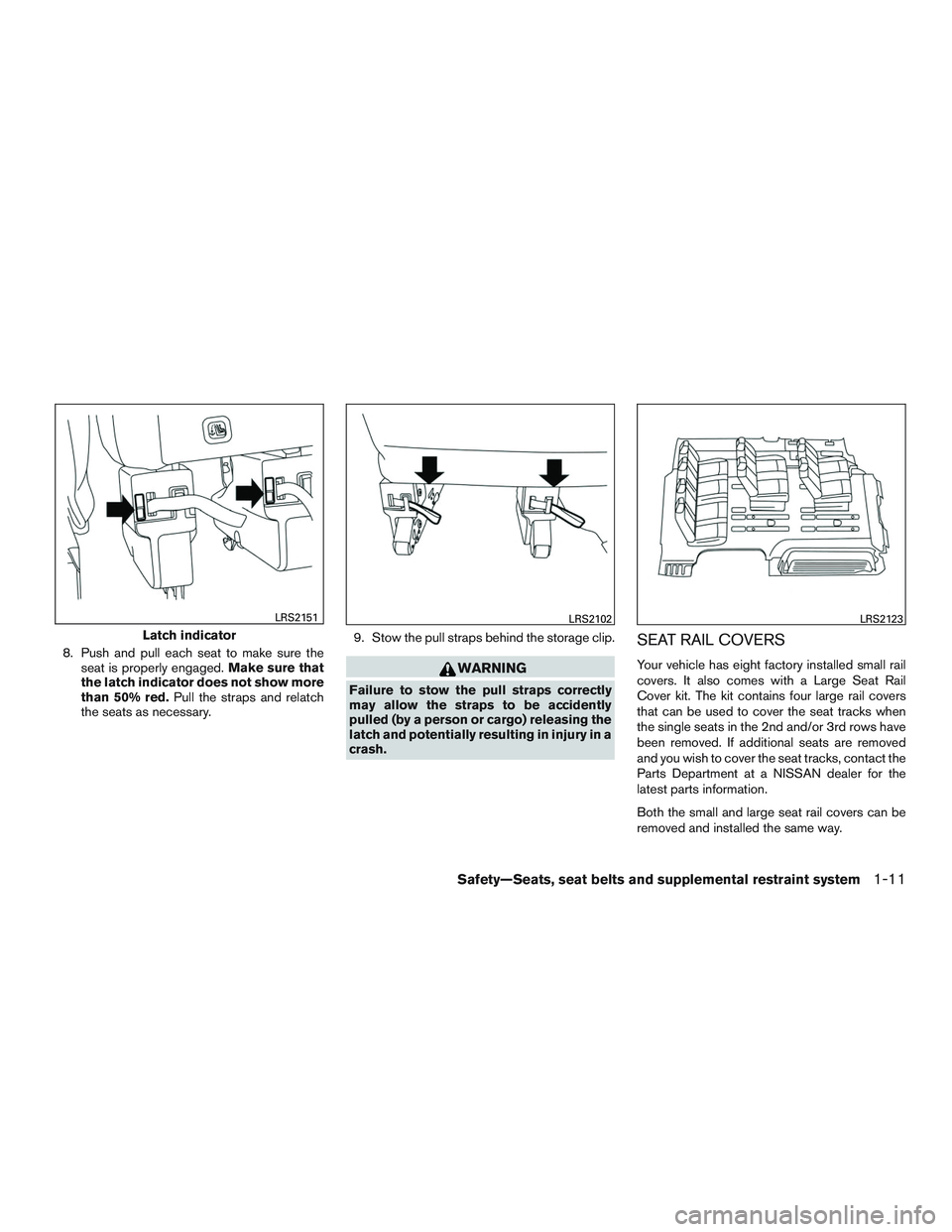
8. Push and pull each seat to make sure theseat is properly engaged. Make sure that
the latch indicator does not show more
than 50% red. Pull the straps and relatch
the seats as necessary. 9. Stow the pull straps behind the storage clip.
WARNING
Failure to stow the pull straps correctly
may allow the straps to be accidently
pulled (by a person or cargo) releasing the
latch and potentially resulting in injury in a
crash.
SEAT RAIL COVERS
Your vehicle has eight factory installed small rail
covers. It also comes with a Large Seat Rail
Cover kit. The kit contains four large rail covers
that can be used to cover the seat tracks when
the single seats in the 2nd and/or 3rd rows have
been removed. If additional seats are removed
and you wish to cover the seat tracks, contact the
Parts Department at a NISSAN dealer for the
latest parts information.
Both the small and large seat rail covers can be
removed and installed the same way.
Latch indicator
LRS2151LRS2102LRS2123
Safety—Seats, seat belts and supplemental restraint system1-11
Page 33 of 380
WARNING
Properly stow the rail covers when not in
use. They should be securely stored to
prevent them from causing injury to pas-
sengers or damage to the vehicle in case
of sudden braking or an accident.
Installation of rail covers
When installing the rail covers into the rail open-
ing, make sure that the Owner’s Manual symbol is
placed in the correct direction.● 2nd row towards front of the vehicle
● 3rd row towards rear of the vehicle To install the rail covers:
1. Remove the locking cap from the cover us- ing a suitable tool, such as a small screw-
driver or key, before installing the cover in the
rail opening.
LRS2124LRS2125
1-12Safety—Seats, seat belts and supplemental restraint system
Page 34 of 380
●Rear heater vent (1)
● Large rail cover (2)
● Small rail cover (3)
2. Clip the large cover into the rail opening. Make sure that the Owner’s Manual symbol
is placed in the correct direction. See previ-
ous illustration. 3. Slide locking cap back into cover after clip-
ping into the rail.Removal of rail covers
To remove the rail covers, remove the locking
caps from the cover using a suitable tool such as
a small screwdriver or key. Then lift the cover from
the rail opening.
WARNING
Properly stow the rail covers when not in
use. They should be securely stored to
prevent them from causing injury to pas-
sengers or damage to the vehicle in case
of sudden braking or an accident.
LRS2127LRS2126LRS2125
Safety—Seats, seat belts and supplemental restraint system1-13
Page 36 of 380
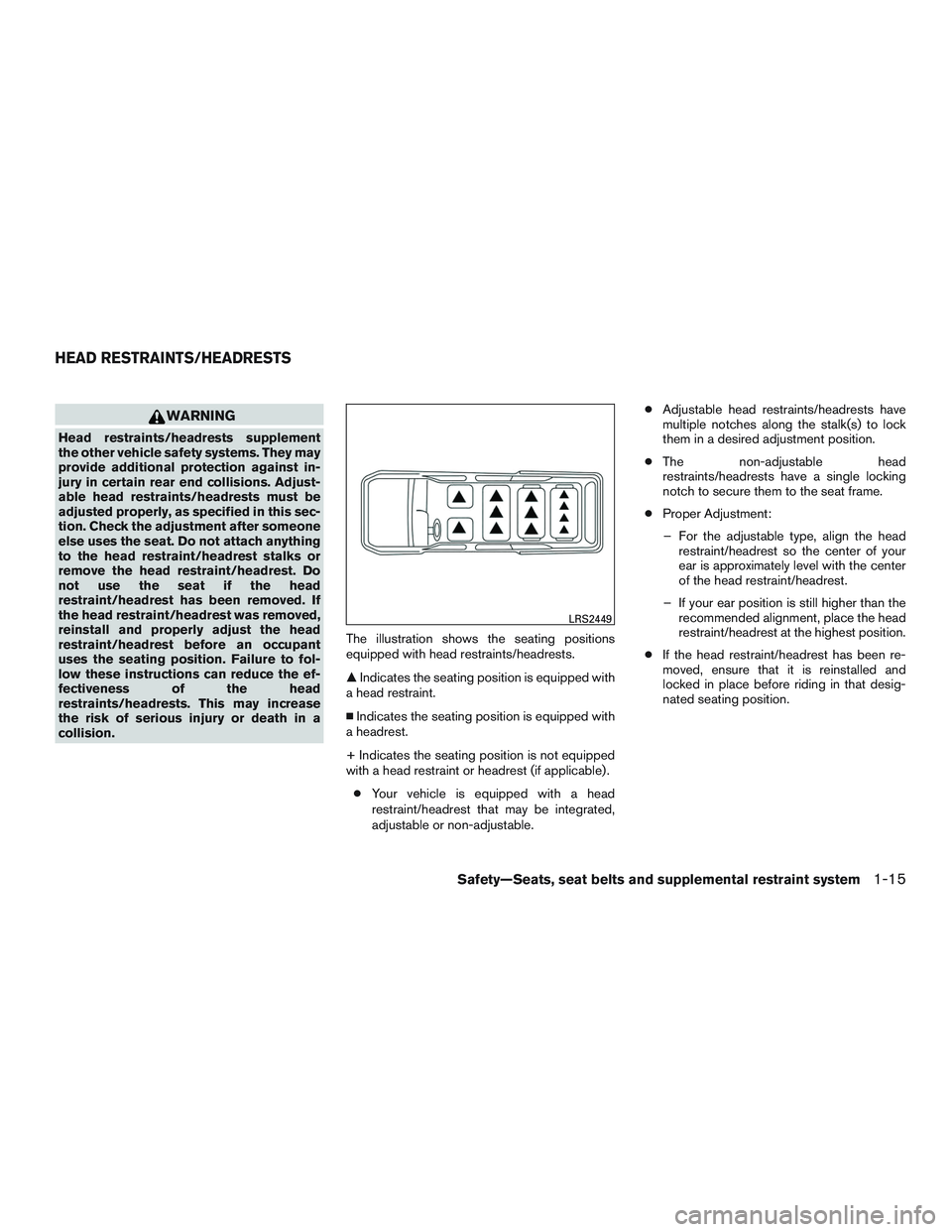
WARNING
Head restraints/headrests supplement
the other vehicle safety systems. They may
provide additional protection against in-
jury in certain rear end collisions. Adjust-
able head restraints/headrests must be
adjusted properly, as specified in this sec-
tion. Check the adjustment after someone
else uses the seat. Do not attach anything
to the head restraint/headrest stalks or
remove the head restraint/headrest. Do
not use the seat if the head
restraint/headrest has been removed. If
the head restraint/headrest was removed,
reinstall and properly adjust the head
restraint/headrest before an occupant
uses the seating position. Failure to fol-
low these instructions can reduce the ef-
fectiveness of the head
restraints/headrests. This may increase
the risk of serious injury or death in a
collision.The illustration shows the seating positions
equipped with head restraints/headrests.
�
Indicates the seating position is equipped with
a head restraint.
� Indicates the seating position is equipped with
a headrest.
+ Indicates the seating position is not equipped
with a head restraint or headrest (if applicable) .
● Your vehicle is equipped with a head
restraint/headrest that may be integrated,
adjustable or non-adjustable. ●
Adjustable head restraints/headrests have
multiple notches along the stalk(s) to lock
them in a desired adjustment position.
● The non-adjustable head
restraints/headrests have a single locking
notch to secure them to the seat frame.
● Proper Adjustment:
– For the adjustable type, align the head restraint/headrest so the center of your
ear is approximately level with the center
of the head restraint/headrest.
– If your ear position is still higher than the recommended alignment, place the head
restraint/headrest at the highest position.
● If the head restraint/headrest has been re-
moved, ensure that it is reinstalled and
locked in place before riding in that desig-
nated seating position.
LRS2449
HEAD RESTRAINTS/HEADRESTS
Safety—Seats, seat belts and supplemental restraint system1-15
Page 41 of 380
WARNING
●Every person who drives or rides in this
vehicle should use a seat belt at all
times. Children should be in the rear
seats and in an appropriate restraint.
WARNING
● The seat belt should be properly ad-
justed to a snug fit. Failure to do so may
reduce the effectiveness of the entire
restraint system and increase the
chance or severity of injury in an acci-
dent. Serious injury or death can occur if
the seat belt is not worn properly.
SSS0134SSS0016
1-20Safety—Seats, seat belts and supplemental restraint system